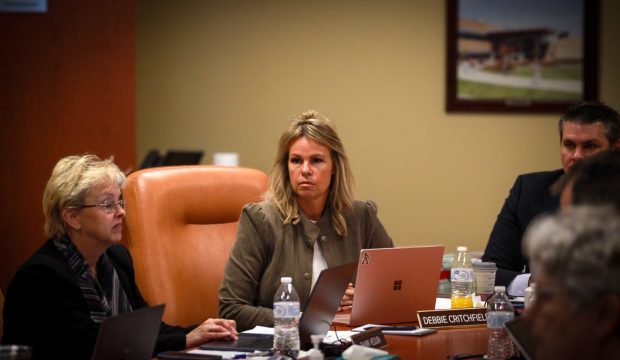One of Gov. Brad Little’s showpiece education programs could be slashed, after lawmakers recommended a conservative revenue forecast for the upcoming fiscal year.
Alex Adams, Little’s budget chief, told the Joint Finance-Appropriations Committee Wednesday that the Empowering Parents program cut is one of a few reductions needed to trim about $100 million from the governor’s budget recommendations.

This comes after the Legislature’s Economic Outlook and Revenue Assessment Committee recommended that JFAC adopt a more conservative revenue forecast — 1.7% less than the governor’s number.
“Revenue forecasting is a fancy way of saying revenue guessing,” Adams told JFAC. “I think it’s very reasonable and appropriate to guess low as a hedge.”
The governor’s budget revisions regularly come early in the session, to correct errors and omissions noticed after the budget is widely shared. But eliminating an entire program — especially one prized by the Republican governor — is out of the ordinary.
The $30 million Empowering Parents program offers students microgrants for out-of-pocket educational expenses, such as textbooks and laptops. The state initiated Empowering Parents in 2022, using $50 million of federal coronavirus aid, but in 2023, Little and the Legislature agreed to use the $30 million in state money to keep the program going.
The 2022 rollout was turbulent — and amidst reports of improper, taxpayer-funded purchases, Little in June ordered an audit of his pet program. The independent audit pinpointed $41,000 in improper purchases — prompting Little to tout Empowering Parents as “a resounding success.”
The Legislature’s economic outlook committee meets with economists and business leaders each year and studies forecasts before recommending to JFAC a limit on how much the state should spend in the coming year. The joint committee last week voted to recommend a $5.6 billion revenue forecast for fiscal year 2025, while the governor’s office predicted the state would collect about $5.7 billion.
“We recommend caution in making appropriations above the committee’s revenue recommendations,” economic outlook committee members said in a letter to JFAC.
Working on $5.6 billion, the governor’s new budget would also trim next year’s ending balance by about $65 million, Adams said. And it would set aside slightly less money in the state’s rainy day fund, which is tied to a percentage of revenue.
JFAC Co-chair Sen. C. Scott Grow, R-Eagle, noted Tuesday that his committee has yet to accept the $5.6 billion forecast.
Critchfield renews pitch for one-time boost in K-12 payments
State superintendent Debbie Critchfield came to the Statehouse Wednesday, renewing a $162 million to $165 million request.

She urged House Education Committee members to free up the money public schools were expecting this year — but didn’t receive. The money is on hold because Idaho abandoned its pandemic-era school funding formula, which was tied to enrollment, returning to a formula tied to student attendance. Since attendance numbers usually fall below enrollment numbers, schools stand to lose money under the attendance-based formula.
While arcane, the attendance-vs.-enrollment formula debate looms as one of the biggest education funding issues of the 2024 session. And for months, Critchfield has urged state leaders to keep schools whole. Her 2024-25 budget proposal, submitted in September, included $92 million to cover the difference.
Since then, the price tag has nearly doubled. But on Wednesday, Critchfield again pointed out that the state already has this money in hand. If it doesn’t go out to the schools, the money would instead slide into the state’s rainy-day fund for public schools, or a bond levy equalization fund designed to offset some school construction costs.
Gov. Brad Little also supports moving money to public schools to offset the funding loss — and Little will finalize his request when the February attendance numbers come in.
In her first presentation to the 2024 Legislature, Critchfield said her Idaho Department of Education is focusing on four far-reaching goals:
- A “back-to-basics” focus on early literacy and math. Idaho’s math scores remain lackluster, with roughly 40% of fifth- through eighth-graders scoring proficient or better on standardized tests in the spring. “We’re not satisfied with where we are.”
- Preparing high school graduates for college and career. Critchfield shared some surprising numbers Wednesday morning. The 2023 Legislature freed up $45 million in one-time money to start new career-technical programs in rural Idaho, and the state received requests for $111 million. “We’ve really gone to work to prioritize and scrutinize.”
- Teacher recruitment and retention. In recent years, studies have shown that 30% of Idaho’s new teachers leave the profession within a few years.
- Making permanent changes in the school funding formula, last rewritten in 1994.
